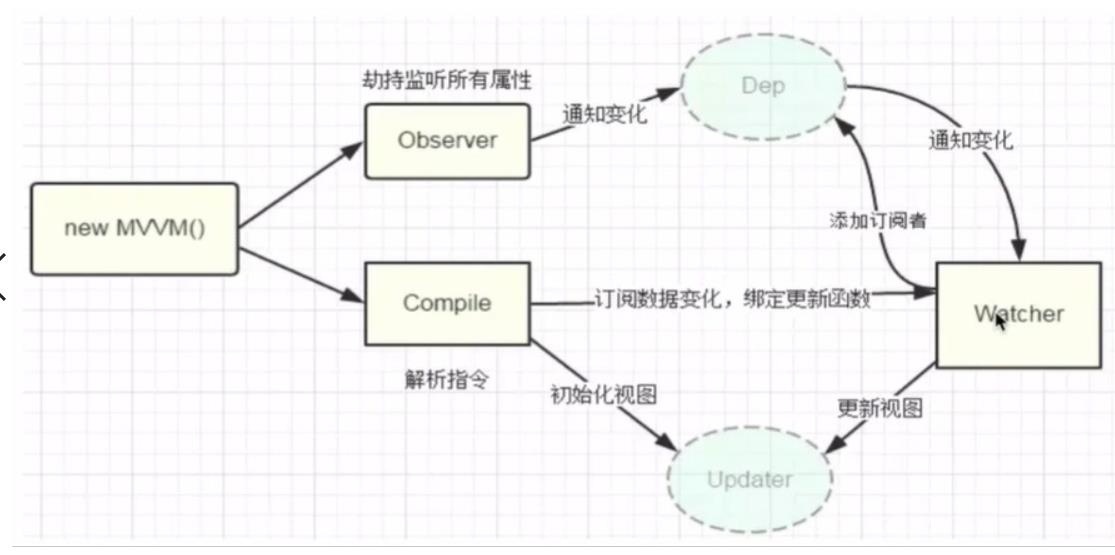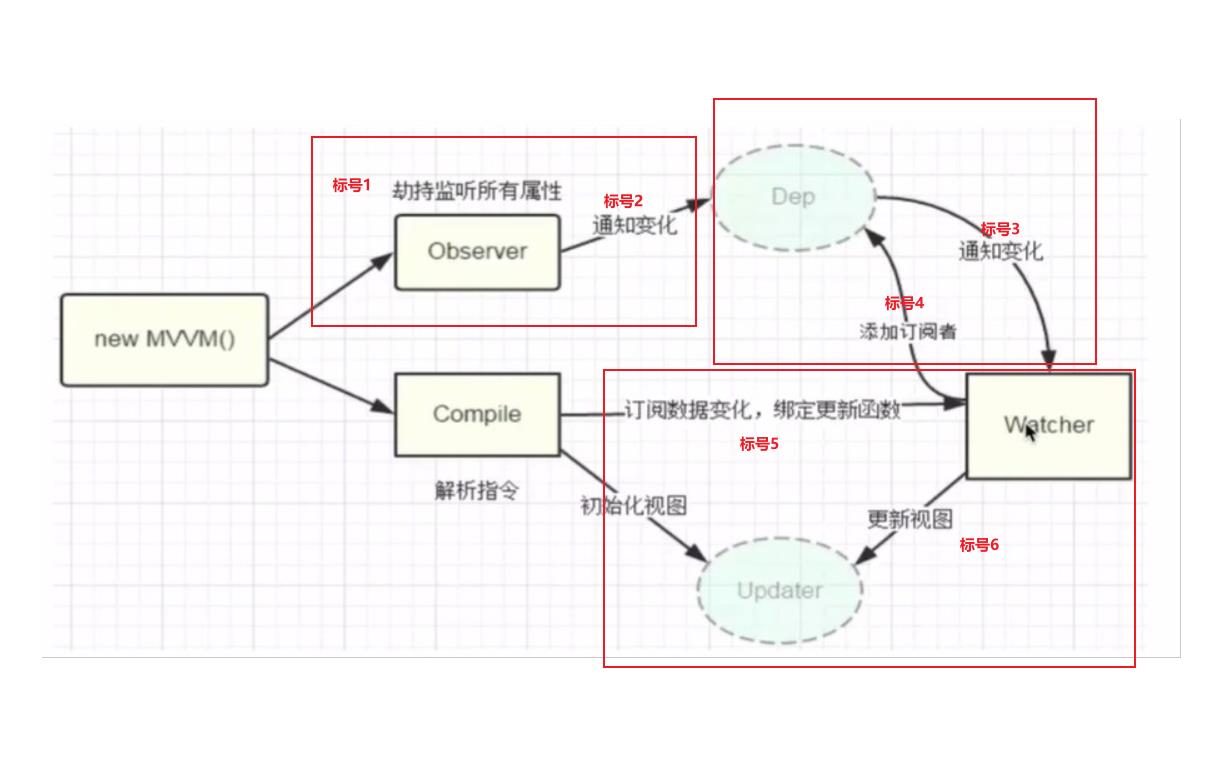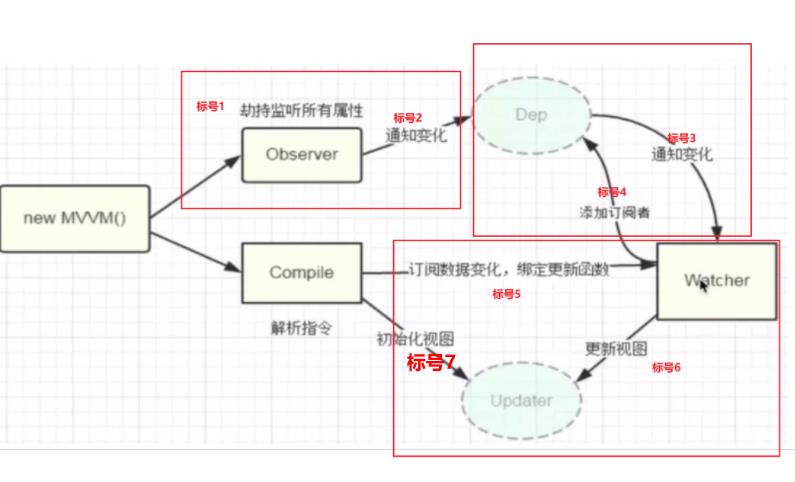学会一个手写一个简单的vue-含视频
Posted 阿锋不知道丶
tags:
篇首语:本文由小常识网(cha138.com)小编为大家整理,主要介绍了学会一个手写一个简单的vue-含视频相关的知识,希望对你有一定的参考价值。
前言
想直接看视频的可以点击下面
视频观看我的手写简单vue全过程
代码地址:https://github.com/Zourunfa/imitate_vue/tree/main
本片文章的讲解步骤不完全按照视频里写代码的思路,但是有详细注释
准备工作
先看下面这张图,我是按照这张图的思路一步一步写的

由于时间原因 ,视频录制中已经把vue的响应式核心的部分串联,但是编译解析部分还只写了mustuche,v-html,v-text的编译解析代码,后面会进一步完善v-model,v-bind等一系列指令
先建立一个文件夹,里面放置index.html如下,然后建立下面引入的几个文件 observer.js和compiler.js,vue.js
<!DOCTYPE html>
<html lang="en">
<head>
<meta charset="UTF-8" />
<meta http-equiv="X-UA-Compatible" content="IE=edge" />
<meta name="viewport" content="width=device-width, initial-scale=1.0" />
<title>Document</title>
</head>
<body>
<div id="app">
<p>{{emp.name}}</p>
<p v-text="emp.hobby"></p>
<div v-html="username"></div>
</div>
<script src="vue.js"></script>
<script src="observer.js"></script>
<script src="compiler.js"></script>
<!-- <script src="https://cdn.jsdelivr.net/npm/vue@2.5.16/dist/vue.js"></script> -->
<script>
let vm = new Vue({
el: '#app',
data: {
username: '阿锋',
msg: 'asdasdsadd',
emp: {
name: 'af',
age: '21',
slary: 8000,
hobby: 'guitar',
},
},
methods: {
handleClick() {
console.log(this.emp.name);
this.emp.name = '你好啊';
},
},
});
</script>
</body>
</html>
vue.js
这就相当于new Vue的入口文件,
class Vue {
constructor(options) {
this.$data = options.data;
this.$el = options.el;
// console.log(options);
this._init();
}
_init() {
// 1.实现一个数据观察者
new Observer(this.$data);
// 2.实现一个指令的解析器
new Compiler(this.$el, this);
}
}
Observer.js

这部分有三个类,分别是Observer类,watcher类,dep类。分别对应上面响应式图的三个,
注意上面视图的标号有对应的代码,在注释里面 标注 提出来看 更方便理解
Observer

class Observer {
constructor(data) {
// console.log(data);
this.observe(data);
}
observe(data) {
if (data && typeof data === 'object') {
// console.log(Object.keys(data));
Object.keys(data).forEach((key) => {
// console.log(`劫持监听所有属性`);
// 对应标号1
this.defineReactive(data, key, data[key]);
});
}
}
defineReactive(obj, key, value) {
// 递归遍历
this.observe(value);
const dep = new Dep();
Object.defineProperty(obj, key, {
enumerable: true,
configurable: false,
get() {
// 编译之前 初始化的时候
// 订阅数据变化时,玩dep中添加观察者
// 对应标号4 和 标号 2
console.log(
`getter劫持${key}时 订阅数据变化时,往dep中添加观察者watcher`,
);
Dep.target && dep.addSub(Dep.target);
return value;
},
set: (newVal) => {
this.observe(newVal);
if (newVal !== value) {
value = newVal;
}
// 告诉dep 通知变化
// 对应标号3
console.log(`setter设置新值时 调用dep.notify通知变化`);
dep.notify();
},
});
}
}
dep
// 收集watcher 通知更新
class Dep {
constructor() {
this.subs = [];
}
// 收集观察者
addSub(watcher) {
this.subs.push(watcher);
}
// 通知观察者更新
notify() {
// 通知标号3
console.log('通知wacher更新', this.subs);
this.subs.forEach((w) => {
w.update();
});
}
}
watcher
class Watcher {
constructor(expr, vm, cb) {
this.vm = vm;
this.expr = expr;
this.cb = cb;
// 把旧值保存
this.oldVal = this.getSub(expr, vm);
}
getSub(expr, vm) {
//当获取旧值时把watcher挂载到当前dep的target上
console.log(
`当在watcher中获取旧值${this.expr}时把watcher挂载到当前dep的target上`,
);
// 对应标号5 编译时会使用new Watcher来使用这个函数
Dep.target = this;
const value = compMidWare.getValue(expr, vm);
//用完之后一定要销毁掉,不然会有重复的watcher
Dep.target = null;
return value;
}
update() {
const newVal = compMidWare.getValue(this.expr, this.vm);
this.cb(newVal);
}
}
compiler.js

这个文件主要是编译解析vue指令 ,然后需要注意的是 我下面代码的compMidWare就相当于图上的updater
注意上面视图的标号有对应的代码,在注释里面 标注 提出来看 更方便理解
class Compiler {
constructor(el, vm) {
this.el = document.querySelector(el);
this.vm = vm;
// 1,获取文档碎片对象 放入内存中会减少页面的回流和重绘
const fragment = this.createFragment(this.el);
// console.log(this.el);
// 2,编译模板
this.compile(fragment);
// 3,追加子元素到根元素上
this.el.appendChild(fragment);
}
createFragment(el) {
// 创建文档碎片对象
const fragment = document.createDocumentFragment();
let firstChild;
// 注意下面是=是赋值 拿到就填进去 并且判断是不是有child
// 把所有节点都追加到fragment对象中
while ((firstChild = el.firstChild)) {
fragment.appendChild(firstChild);
}
return fragment;
}
compile(fragment) {
const childNodes = fragment.childNodes;
// console.log(childNodes);
[...childNodes].forEach((node) => {
if (node.nodeType === 1) {
// 如果是元素节点,就编译它
this.compileNode(node);
} else {
// 文本节点
// 编译文本节点
this.compileText(node);
}
// 递归
node.childNodes && this.compile(node);
});
}
compileNode(node) {
// console.log(node);
const attributes = node.attributes;
// console.log(attributes);
[...attributes].forEach((attr) => {
// console.log(attr);
const { name, value } = attr;
// console.log(name, value);
// 's'.startsWith
const expr = value;
if (name.startsWith('v-')) {
const orderName = name.split('-')[1];
// console.log(orderName);
compMidWare[orderName](expr, node, this.vm);
}
//
});
}
compileText(node) {
const text = node.textContent;
// console.log(text);
if (/\\{\\{(.+?)\\}\\}/.test(text)) {
// console.log(node);
const expr = text.replace(/\\{\\{(.+?)\\}\\}/, (...args) => {
// console.log(args);
return args[1];
});
// console.log(expr);
console.log(expr);
compMidWare['text'](expr, node, this.vm);
}
}
}
const compMidWare = {
// 这里用到reduce很巧妙 . 之前的pres刚好就是 . 之后的上一级对象
getValue(expr, vm) {
return expr.split('.').reduce((pres, cur) => {
return pres[cur];
}, vm.$data);
},
html(expr, node, vm) {
// console.log(expr, node, vm);
const value = this.getValue(expr, vm);
// console.log(value);
// 绑定观察者,将来数据发生变化 触发这里的回调 进行更新
// 对应标号5
new Watcher(expr, vm, (newValue) => {
// console.log(newValue);
this.toView.htmlToView(node, newValue);
});
// 对应标号7
console.log(`更新当前${expr}-${value}到视图上`);
this.toView.htmlToView(node, value);
},
text(expr, node, vm) {
// console.log(expr, node, vm);
// console.log(expr);
const value = this.getValue(expr, vm);
// console.log(value);
// 绑定一个watcher对值进行监听 标号5
new Watcher(expr, vm, (newValue) => {
// console.log(newValue);
console.log(`订阅数据变化,绑定更新函数:更新${expr} 为 ${newValue}`);
this.toView.textToView(node, newValue);
});
// // 对应标号7
console.log(`更新当前${expr}-${value}到视图上`);
this.toView.textToView(node, value);
},
on() {},
model() {},
toView: {
htmlToView(node, value) {
node.innerHTML = value;
},
textToView(node, value) {
node.textContent = value;
},
},
};
以上是关于学会一个手写一个简单的vue-含视频的主要内容,如果未能解决你的问题,请参考以下文章